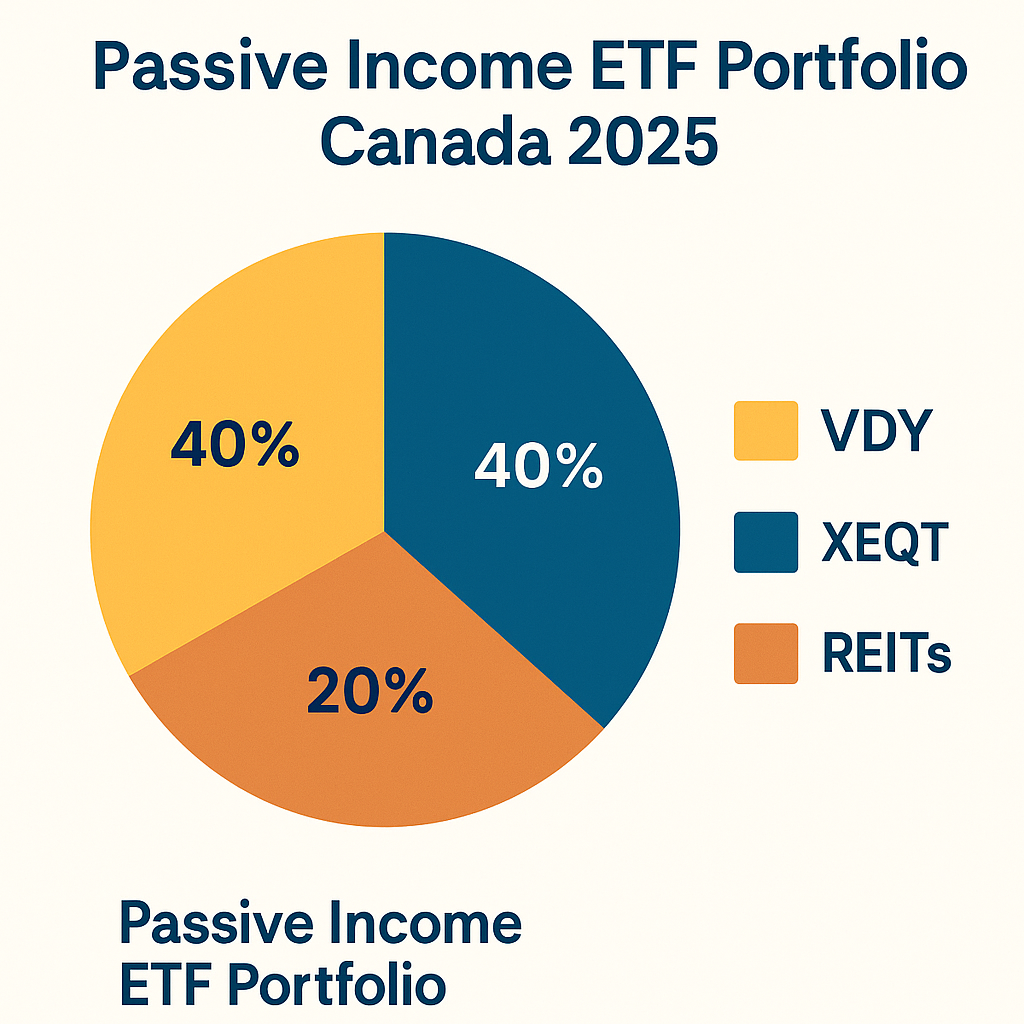Disclosure: This post may contain affiliate links. We may earn a commission if you sign up through our links, at no extra cost to you.

Introduction
Every Canadian wants passive income, but most have no idea where to start. The truth is, passive income investing in Canada in 2025 has never been more accessible. With ETFs, robo-advisors, REITs, and digital income tools, you can build long-term wealth even if you’re starting with $25–$100.
This guide breaks down the best passive income investments in Canada, how they work, and how to build a portfolio that pays you, month after month, year after year.
Related posts:
What Is Passive Income (The Real Definition)?
Passive income doesn’t mean “free money.”
It means: set it up once, earn for years.
It includes two categories:
1. Truly Passive Investments
- Dividend stocks
- ETFs
- Robo-advisors
- REITs
- GIC ladders
2. Semi-Passive Income Streams
(Requires upfront work but pays over time)
- Blogs
- YouTube
- Ebooks
- Affiliate marketing
- AI automation tools
For Canadians, passive income is the most reliable path to long-term financial freedom, especially when built inside a TFSA or RRSP.
Best Passive Income Investments in Canada (2025)

1. Dividend Stocks
Dividend stocks pay you every quarter, regardless of what the stock price is doing.
Top Canadian picks:
- Fortis (FTS)
- Canadian Utilities (CU)
- BCE
Why they work:
- Predictable payouts
- Tax-efficient in a TFSA
- Long history of growing dividends
📌 Tip: Turn on a DRIP to reinvest dividends automatically.
Coming soon: Best Canadian Dividend Stocks for 2025
2. Dividend ETFs
Dividend ETFs give you instant diversification + steady income.
Top picks:
- VDY – Vanguard Canadian High Dividend Yield
- XEI – iShares Canadian Select Dividend
- ZDV – BMO Canadian Dividend ETF
These are perfect for long-term passive income.
Read: Best Dividend ETFs in Canada 2025
3. Index ETFs & All-In-One ETFs
Not high yield, but massive long-term growth, a form of passive income through capital appreciation.
Top picks:
- VEQT (Vanguard)
- VGRO (Vanguard)
- XEQT (iShares)
- XGRO (iShares)
Perfect for beginners who want one ETF that does everything.
4. Robo-Advisors

A true “set it and forget it” passive investment.
Top robo-advisors in Canada:
How it works:
- Set up your account
- Answer a few risk questions
- Deposit money automatically
- Portfolio rebalances itself
Learn more: Best Robo-Advisors in Canada 2025
5. REITs (Real Estate Investment Trusts)
Real estate income without buying a house.
Popular Canadian REITs:
Why REITs work:
- Monthly income
- Lower entry cost
- Great diversification
6. High-Interest Savings Accounts & GIC Ladders
Not exciting, but reliable.
Best Canadian options:
Highly recommended for emergency funds and low-risk income.
7. Digital & Semi-Passive Income Assets
Not stocks, but still legitimate passive income.
Examples:
- Niche blog (like The Maple Mentor)
- YouTube channels (faceless options work)
- Ebooks & AI-written templates
- Affiliate marketing
- Automation tools (AI bots, SaaS)
These take more effort upfront but can scale extremely well.
How Much Money Do You Need to Start?
You can start passive income investing in Canada with $25–$100.
Example scenarios:
📌 $100/month in a dividend ETF (4% yield)
→ ~$1,500/year income after 10 years
📌 $500/month in VEQT (8% growth)
→ ~$100,000+ in 10 years
Time matters more than the amount.
TFSA vs RRSP vs FHSA for Passive Income
TFSA
- Best for dividends & ETFs
- Tax-free income forever
RRSP
- Best for U.S. dividend stocks (no withholding tax)
- Taxed later in retirement
FHSA
- Great for first-time home buyers
- Tax-deductible contributions + tax-free withdrawals
Full comparison: TFSA vs RRSP vs FHSA 2025
How to Build a Passive Income Portfolio (Step-by-Step)
Step 1 — Pick your account (TFSA/RRSP/FHSA)
Step 2 — Choose 2–4 ETFs
Step 3 — Set up automatic deposits
Step 4 — Reinvest all dividends
Step 5 — Review once per year (not weekly!)
Consistency > timing.
Passive Income Investing Mistakes to Avoid
- Chasing high-yield ETFs (8–12% = dangerous)
- Not diversifying (owning only one stock)
- Panic selling during market dips
- Withdrawing from TFSA too often (losing contribution room)
Read next: How to Avoid Common Investing Mistakes 2025
Example: $500/Month Passive Income Portfolio

| ETF | Description | Allocation |
|---|---|---|
| VDY | Canadian dividend stocks | 40% |
| XEQT | Global growth ETF | 40% |
| REITs | Real estate monthly income | 20% |
Expected return: ~7–8% per year
Great for long-term Canadians who want balance + income.
Final Thoughts
Passive income isn’t magic, it’s a long-term strategy. The earlier you start, the easier it becomes to build real wealth.
You don’t need thousands to begin. You just need consistency, patience, and the right investments.
Recommended next reads:

